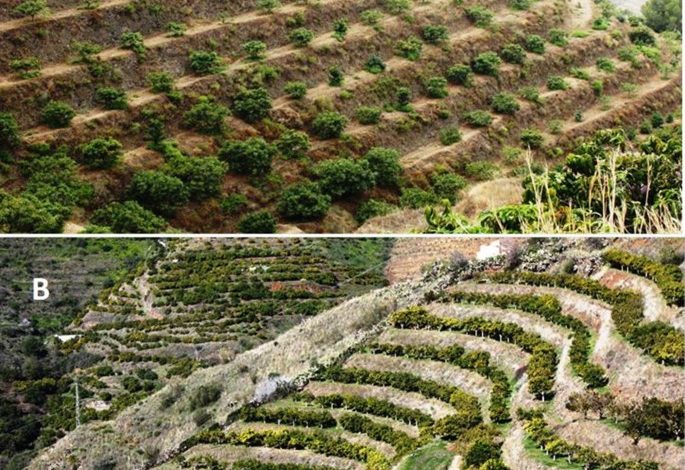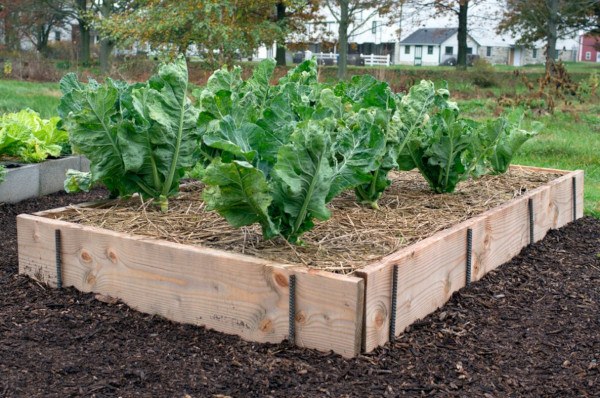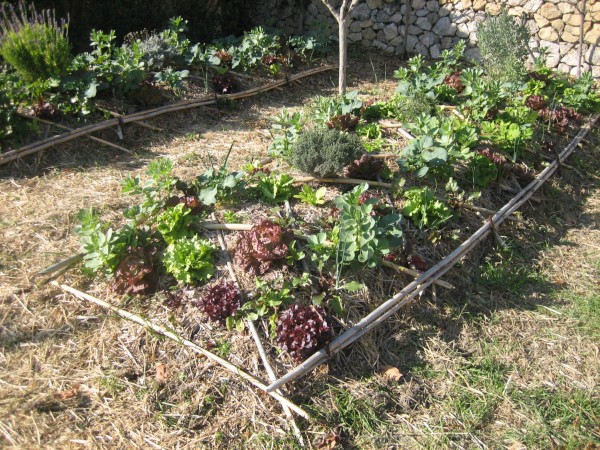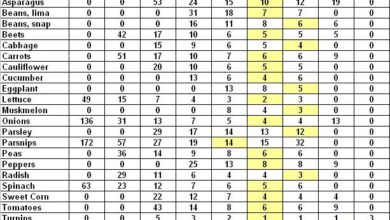Terraces in the recycled orchard: How to delimit the crops

Various studies support that the surface yield with the terrace system doubles or triples that achieved conventionally with furrows or lines. The secret is that copiously fertilizing the terrace, with a soft and untrodden soil, much more dense planting than usual is achieved, associating plants with different foliage or root development. This allows better moisture conservation while the shade of the plant mass makes it difficult for weeds to proliferate and the few that do grow are easily uprooted thanks to the soft soil.

How to create recycled beds in the garden
To create a terrace it is not necessary to spend money, so today I am going to explain how to make your own recycled terraces.Do not miss it!
BRAIDED BRANCHES
Look for young, flexible branches. Put short and solid stakes every 50 or 60 cm. Then you must intertwine the branches between the stakes one by one, passing once in front and once behind, leaving the stakes protruding at least 2 cm from the braid. As stakes, you can use old wooden tool handles which are usually quite strong. The branches are damaged by being in contact with moist soil and you must renew them every 3 or 5 years.
WOOD PLANKS
You can use, for example, parts of old pallets. Dig a furrow 5 to 6 cm deep, a little more in hard soils. Install a layer of gravel at the bottom and place the planks on top. Fill with soil and press so that it is well compacted. Drive a solid stake into each end of the board, on the outside, and another in the center on the garden side.
In order for the margins to hold, both in this technique and in the braiding technique, the stakes must be buried at least a third of their height. The plates can be kept for 5 to 6 years if you have placed them on a bed of gravel and if you cover the part to be buried with Norwegian tar.
GLASS BOTTLES
Reuse glass bottles placed upside down, that is, with the nozzle buried in the ground following the shape you want to create.
VEGETABLE MARGINS
Made from bush cuttings, for example, boxwood, rosemary and thyme are easily reproduced using this technique and will give a very decorative touch to the garden. In addition, as they are aromatic shrubs, they can help to drive away pests and attract pollinators to your garden.
SEASONAL TERRACES
You can also make a fixed square with four old planks and metal fixings for the angles. You can place this box on the ground in spring, and after the last harvests, it is stored to protect it from winter.
Uniformity is not essential, if you mix beds of different materials your garden will have much more charm. Once placed, the recycled borders do not need maintenance, with one exception: if you create vegetable borders you will have to trim it once or twice a year.

How to organize the garden in sections?
Organizing the garden in squares is not only a matter of design or decoration, but it is also a way to make gardening tasks easier. They do not have to be exact squares, the idea is to create a simple and symmetrical geometric shape, beautiful to look at and somewhat elevated.
This is because it is much easier to sow or plant in regular lines, as well as being more comfortable when carrying out maintenance tasks or at harvest time. Organizing the garden in squares allows you to have a surface that can be planted or sown in a few hours, just in an afternoon.
Forget about circles or triangles if you want to reduce efforts, although if you don’t mind doing a little more work, they can be very decorative.

How do I start designing the garden?
You can start with a square of 1 or 1.5 m. This area would have to be enough to produce at least one plate of vegetables for 3 or 4 people. Subdivide it into 9 squares, like a chessboard; To do this, draw limits on the ground using ropes or sticks and plastic tape. Remove weeds and till the ground if necessary.
Now outline the square with a border about 20 cm wide using the techniques explained above. Fill it with a mixture of mulch, topsoil and compost or organic fertilizer, thus creating an ideal substrate for your vegetables. This is one of the advantages of using orchards in somewhat elevated squares, as they force us to use a new substrate, different from the land of the original land, which is not always the most suitable for cultivation.
Taking care of a small square like the one in the example requires no more than 5 minutes a day, within the reach of even the busiest person in the world. In autumn, after the harvest, cover the entire surface of the square with compost if you want to continue using it. If not, remove the margins and mix the enriched mulch with your garden soil.
I hope that this article will be very useful for you to create terraces in your organic garden and that you share your experiences with all of us. See you in the next article!



![Photo of Chamaecyparis Lawsoniana: [Cultivation, Care, Pests and Diseases]](https://www.complete-gardening.com/wp-content/uploads/2022/08/chamaecyparis-lawsoniana-cultivation-care-pests-and-diseases-390x220.jpg)
